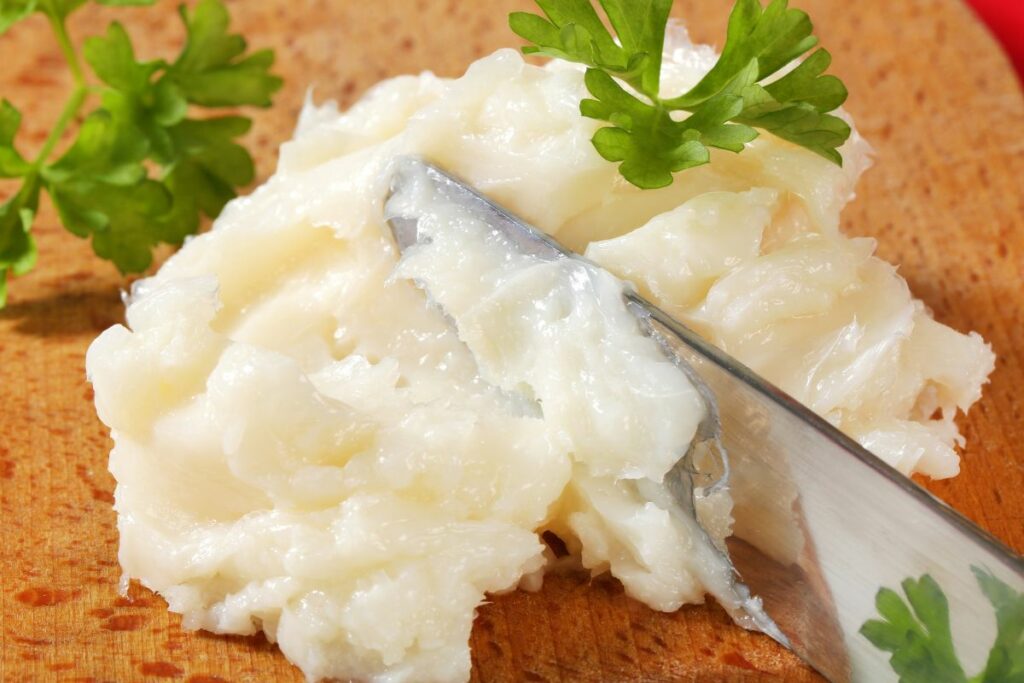Lard is a type of fat that has been used in cooking and baking for centuries. However, due to its high saturated fat content, many people are looking for healthier alternatives to use in their recipes. Fortunately, there are several substitutes that can be used in place of lard.
One of the most popular substitutes for lard is butter. Butter can be used in most recipes that call for lard, and it can help retain the taste and texture of the final product. Other alternatives to lard include shortening, vegetable oil, olive oil, coconut oil, margarine, ghee, beef tallow, avocado, and mashed banana. Each of these substitutes has its own unique flavor and texture, so it’s important to choose the right one for your recipe.
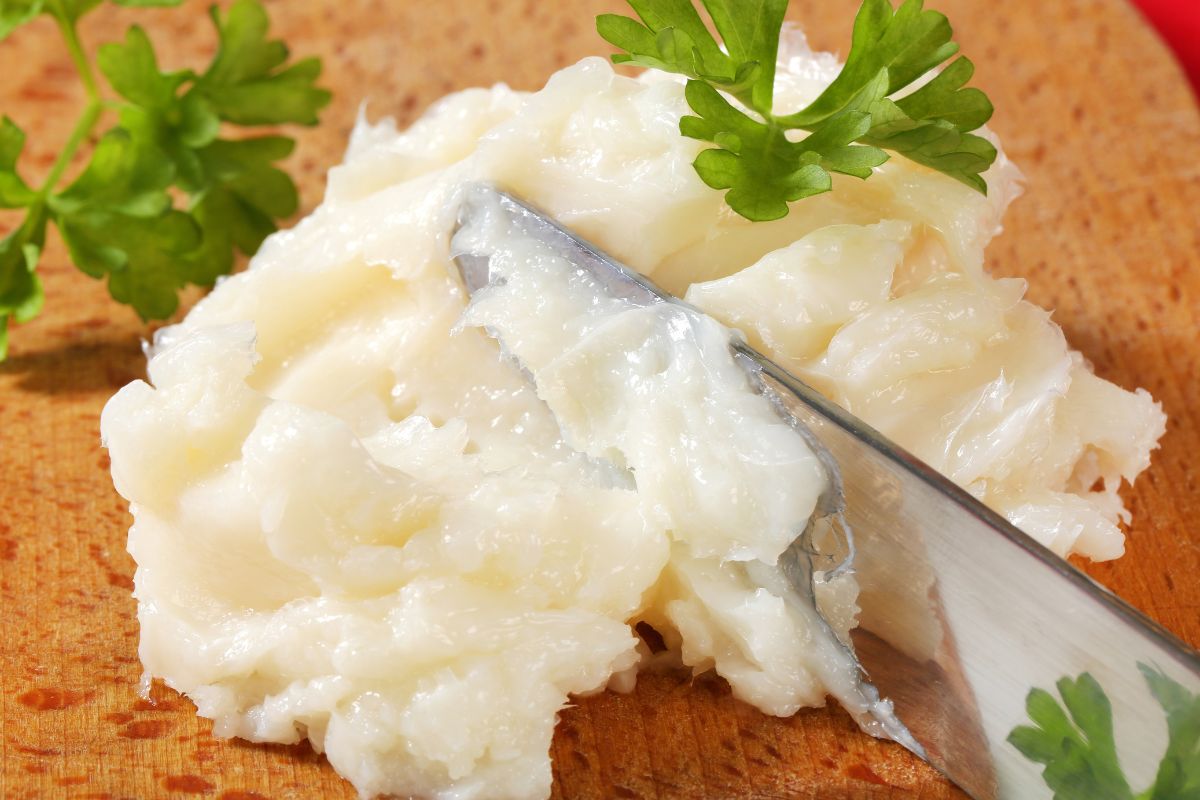
Contents
- 1 Understanding Lard
- 2 Lard in Cooking
- 3 Lard in Baking
- 4 Lard Substitute Options
- 5 Vegetable-Based Substitutes
- 6 Butter and Its Variants as Substitutes
- 7 Oil-Based Substitutes
- 8 Other Unique Substitutes
- 9 Choosing the Right Substitute
- 10 Substitutes for Specific Recipes
- 11 Health Considerations
- 12 Considerations for Dietary Restrictions
- 13 Lard and Its Substitutes in Grocery Stores
Understanding Lard
Lard is a type of fat that comes from pigs. It is made by rendering pork fat, which means heating it until the fat separates from the meat and turns into a liquid. Once the liquid has cooled, it solidifies into a white, semi-solid substance.
Lard has been used in cooking and baking for centuries, and it is still popular today because it is versatile and has a unique flavor. Depending on how it is rendered, lard can be tasteless and odorless or have a slightly porky flavor.
Lard is a type of animal fat, which means it is high in saturated fat. This has led to some controversy over the years, with some people claiming that lard is unhealthy and should be avoided. However, recent research has shown that lard is not as bad for you as previously thought. In fact, lard is lower in saturated fat than butter and has no trans fats.
While lard is a popular ingredient in many recipes, some people choose to avoid it for health or personal reasons. Fortunately, there are many lard substitutes available that can be used in place of lard in most recipes. Some popular substitutes include butter, coconut oil, vegetable oil, and olive oil.
Overall, lard is a versatile and flavorful ingredient that has been used in cooking and baking for centuries. While it is high in saturated fat, recent research has shown that it is not as unhealthy as previously thought. However, for those who choose to avoid lard, there are many substitutes available that can be used in its place.
Lard in Cooking
Lard is a popular cooking fat that has been used for centuries in many recipes. It is especially popular for frying and baking, as it has a high smoke point and adds a unique flavor to dishes. However, some people prefer to avoid lard for health or dietary reasons, and may need to find a suitable substitute.
When cooking with lard, it is important to keep in mind that it is a solid fat at room temperature. This means that it needs to be melted before use in recipes that call for liquid fats. Lard can also be used in place of butter or shortening in pie crusts and other pastry recipes, as it adds a flaky texture and savory flavor.
For frying, lard is an ideal choice as it can withstand high temperatures without smoking or burning. It is commonly used for frying chicken, fish, and other meats, as well as for making crispy fried potatoes and other vegetables. When using lard for frying, it is important to use a deep fryer or a heavy-bottomed skillet to prevent splatters and burns.
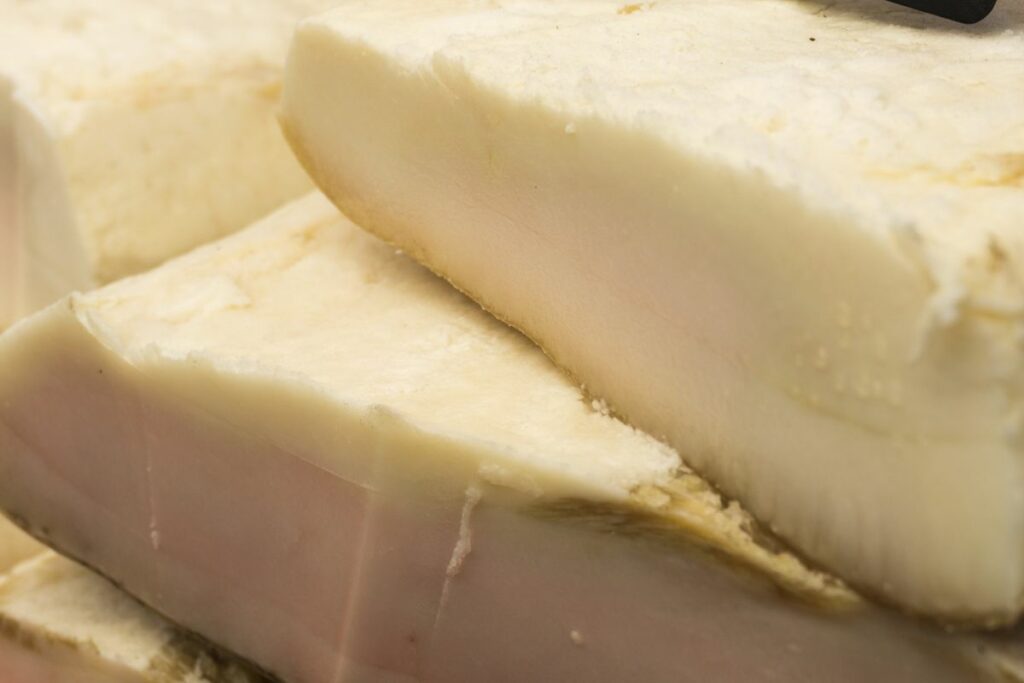
In baking, lard is often used in recipes for biscuits, cakes, and other pastries. It adds a rich, buttery flavor and helps create a tender, flaky texture. However, it can be replaced with other fats such as butter or vegetable shortening if desired. When substituting lard in baking recipes, it is important to consider the smoke point and flavor of the replacement fat.
Overall, lard is a versatile cooking fat that can be used in many recipes. However, for those who prefer to avoid lard, there are many suitable substitutes available such as butter, vegetable shortening, and various cooking oils.
Lard in Baking
Lard has been a staple in baking for centuries, especially in old-fashioned recipes. It is often used in pie crusts, biscuits, and other baked goods to create a flaky texture and enhance the flavor.
However, lard is not a suitable option for everyone. Some people avoid it due to dietary restrictions or personal preferences. Luckily, there are several substitutes available that can provide similar results.
One of the most popular substitutes for lard in baking is butter. Butter has a similar fat content and flavor to lard, making it an excellent option for pie crusts, cookies, cakes, muffins, and bread. However, it is essential to note that butter contains water, which could affect the texture of baked goods. Baked goods made with butter might not be as flaky as those made with lard.
Another popular option for lard substitute in baking is vegetable shortening. It is a plant-based alternative to lard that can provide a similar texture and flavor. Vegetable shortening is often used in pie crusts, cookies, and cakes. It is also a preferred choice for bakers who want to avoid animal-based products.
Other substitutes for lard in baking include olive oil, coconut oil, margarine, and ghee. Each of these options has its unique flavor and texture, and it is essential to experiment to find the best substitute for a particular recipe.
In conclusion, while lard has been a staple in baking for centuries, it is not a suitable option for everyone. Luckily, there are several substitutes available that can provide similar results. Bakers can experiment with different options to find the best substitute for their recipes.
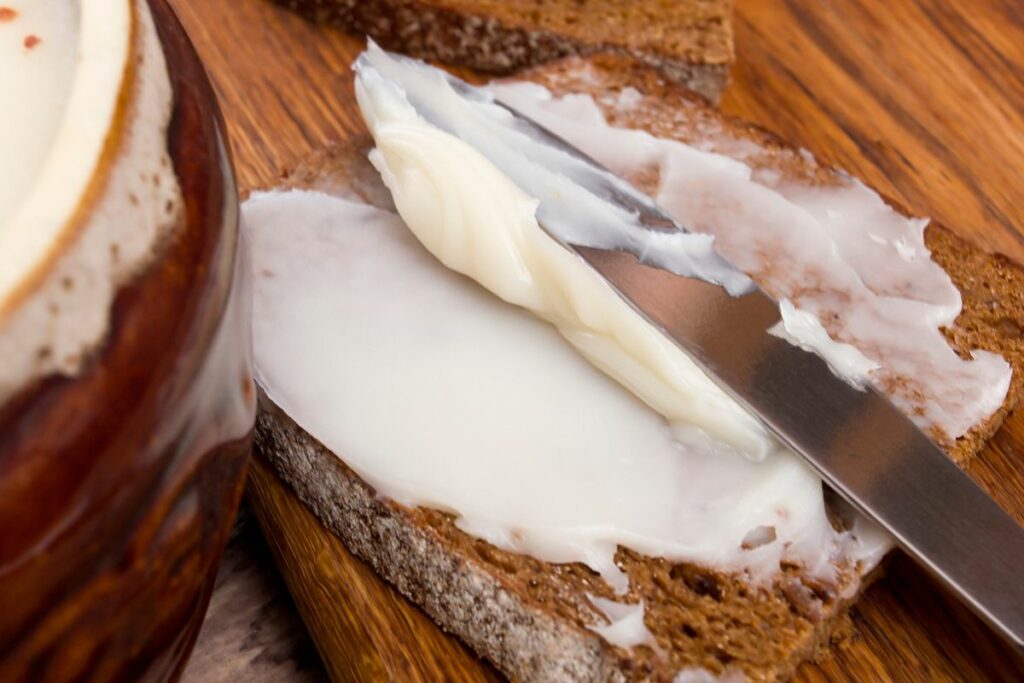
Lard Substitute Options
When it comes to cooking and baking, lard is a popular ingredient used for its unique flavor and texture. However, for those who prefer not to use lard or have dietary restrictions, there are several options available as substitutes. Here are some lard substitute options to consider.
Butter
Butter is a common substitute for lard in most recipes. It is an excellent choice for baking and roasting, as it retains the taste and texture of the final product. When using butter as a substitute, it is best to use unsalted butter to avoid altering the recipe’s flavor.
Vegetable Shortening
Vegetable shortening is another popular substitute for lard. It is a solid fat that can be used for frying, baking, and roasting. Unlike lard, vegetable shortening is vegan and contains no cholesterol, making it a healthier option.
Coconut Oil
Coconut oil is a versatile substitute for lard that can be used for cooking, baking, and frying. It adds a unique flavor to the final product and is a great option for those who are looking for a healthy alternative to lard. Coconut oil is high in healthy fats and has several health benefits.
Olive Oil
Olive oil is an excellent substitute for lard in recipes that require sautéing or frying. It is a healthy fat that is rich in monounsaturated fatty acids and has several health benefits. However, it is important to note that olive oil has a distinct flavor that may alter the recipe’s taste.
Margarine
Margarine is a popular substitute for lard that can be used for baking, frying, and cooking. It is a vegan option that contains no cholesterol and is lower in saturated fat than lard. However, it is important to choose a margarine that is free from trans fats and has a similar texture to lard.
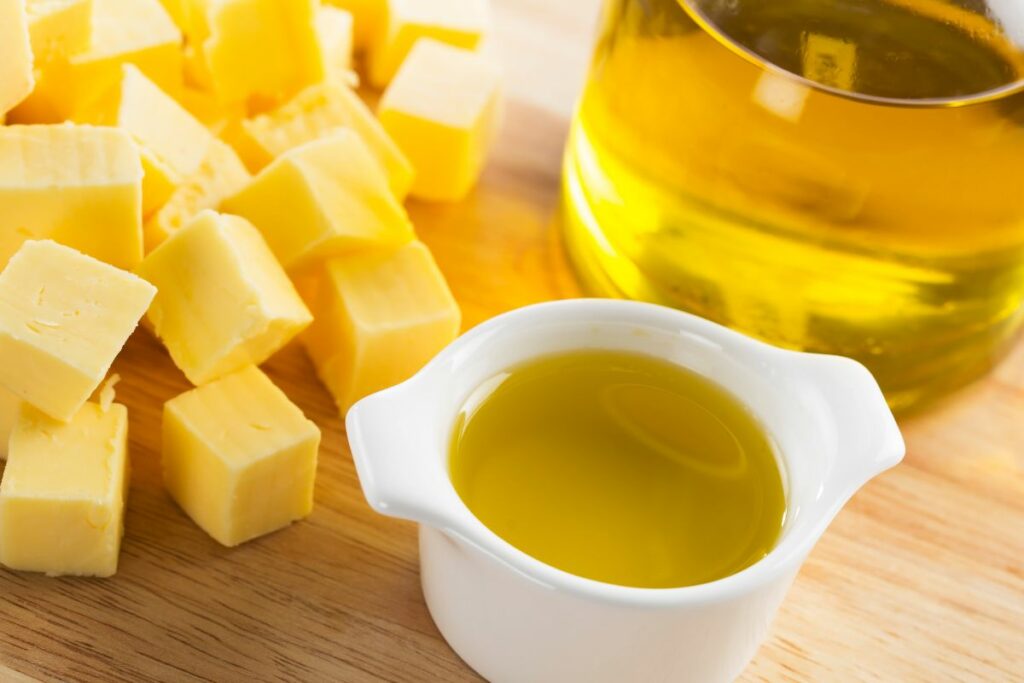
Ghee
Ghee is a type of clarified butter that is commonly used in Indian cuisine. It is a healthy substitute for lard that can be used for cooking, baking, and frying. Ghee has a high smoke point, making it an excellent option for high-temperature cooking.
Other Substitutes
Other lard substitutes include applesauce, mashed bananas, tofu, and yogurt. These substitutes are best used in baking recipes and can be used to replace lard in a 1:1 ratio. However, it is important to note that these substitutes may alter the recipe’s taste and texture.
In conclusion, there are several lard substitute options available for those who prefer not to use lard or have dietary restrictions. When choosing a substitute, it is important to consider the recipe’s requirements and the substitute’s flavor and texture.
Vegetable-Based Substitutes
For those looking for a plant-based alternative to lard, there are several vegetable-based substitutes available. These substitutes can be used in cooking and baking, and some even offer health benefits.
Vegetable Oil
One of the most common vegetable-based substitutes for lard is vegetable oil. It is a versatile and readily available option that can be used in a variety of dishes. Vegetable oil can be used for frying, sautéing, and baking. It is also a healthier option than lard, as it is lower in saturated fats.
Vegetable Shortening
Vegetable shortening is another popular substitute for lard. It is made from vegetable oils and is commonly used in baking. It has a similar consistency to lard and can be used in equal amounts in recipes. However, it is important to note that vegetable shortening is high in trans fats, which can be harmful to health.
Avocado
Mashed avocado can also be used as a substitute for lard. It is a healthier option, as it is rich in monounsaturated fats, which can help reduce the risk of heart disease. Avocado can be used in baking and cooking, but it may alter the taste and texture of the final product.
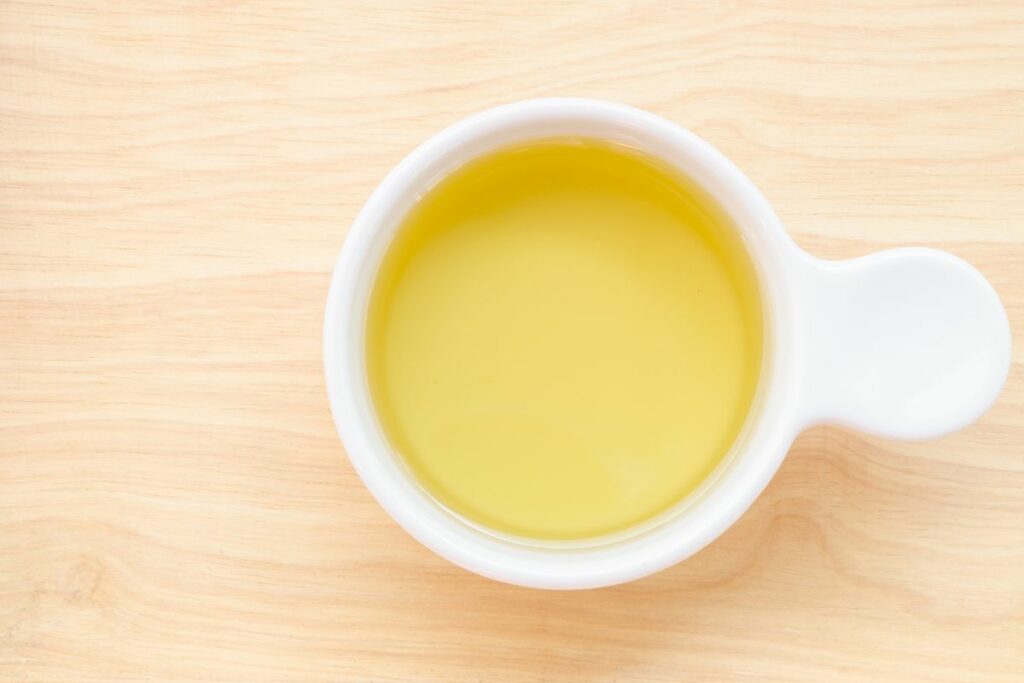
Soybean Oil
Soybean oil is another vegetable-based substitute for lard. It is a popular choice for frying and sautéing, as it has a high smoke point. Soybean oil is also low in saturated fats and high in polyunsaturated fats, which can help improve cholesterol levels.
Palm Oil
Palm oil is another vegetable-based substitute for lard. It is commonly used in baking and cooking and has a similar consistency to lard. However, it is important to note that palm oil is high in saturated fats and can have negative environmental impacts.
Canola Oil
Canola oil is a healthier alternative to lard, as it is low in saturated fats and high in monounsaturated fats. It is a versatile oil that can be used in cooking and baking. Canola oil has a mild flavor that will not alter the taste of the final product.
In summary, there are several vegetable-based substitutes for lard that can be used in cooking and baking. These substitutes offer a healthier option and can provide unique flavors and textures to dishes. It is important to choose a substitute that is appropriate for the recipe and to use it in moderation.
Butter and Its Variants as Substitutes
Butter is one of the most common substitutes for lard in baking and cooking. It is a versatile ingredient that can help retain the taste and texture of the final product. Unless the recipe says otherwise, unsalted butter is the best substitute for lard.
Butter contains water, which could affect the texture of baked goods. Baked goods made with butter might not be as flaky as those made with lard. However, with some minor modifications to the recipe, butter can be used in most recipes that call for lard.
Margarine is another popular substitute for lard. It is made from vegetable oil and can be used in equal amounts as lard. Margarine has a similar consistency and fat content as lard, but it may not have the same flavor. Some margarine brands may also contain trans fats, which are not healthy.
Ghee is a type of clarified butter that is commonly used in Indian cuisine. It has a high smoke point, which makes it ideal for frying and sautéing. Ghee has a nutty flavor and can be used as a substitute for lard in recipes that require a rich, buttery flavor.
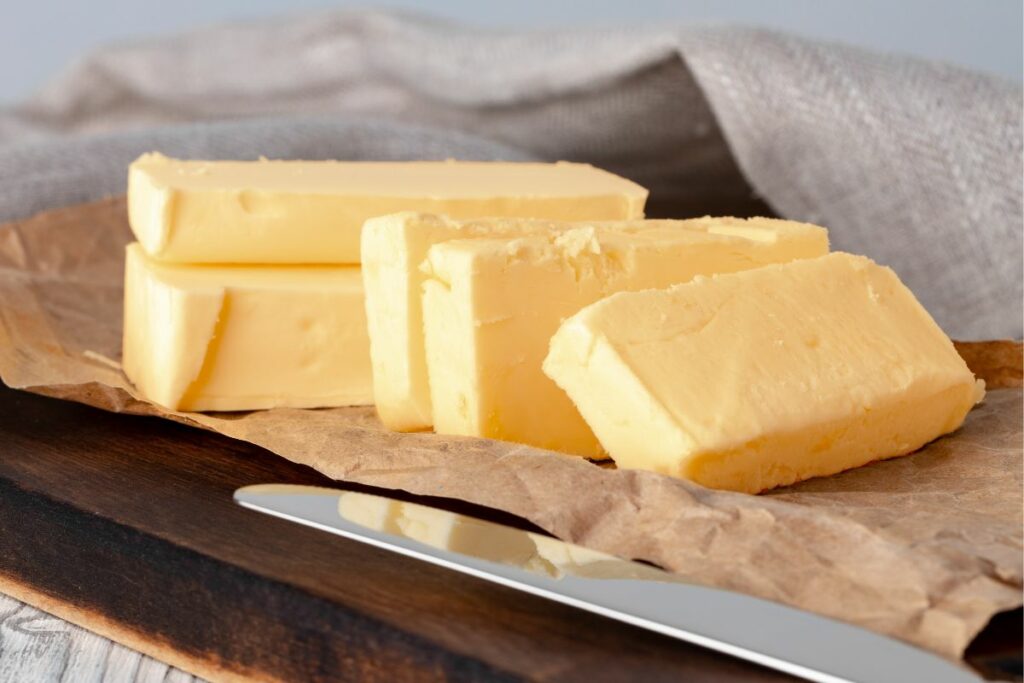
Clarified butter is another type of butter that can be used as a substitute for lard. It is made by heating butter until the milk solids separate from the fat. Clarified butter has a higher smoke point than regular butter, which makes it ideal for high-heat cooking methods like frying and sautéing.
Overall, butter and its variants are great substitutes for lard in most recipes. They are readily available and easy to use. However, it is important to note that they may not have the same flavor or texture as lard, so some minor modifications to the recipe may be necessary.
Oil-Based Substitutes
For those looking for a healthier alternative to lard, oil-based substitutes are a great option. They are low in saturated fat and have a high smoke point, making them ideal for high-temperature cooking methods like frying. Here are some of the best oil-based substitutes for lard:
Coconut Oil
Coconut oil is a popular substitute for lard due to its high smoke point and neutral flavor. It is also a great option for those following a vegan or dairy-free diet. However, it is important to note that coconut oil is high in saturated fat, so it should be used in moderation.
Olive Oil
Olive oil is another healthy substitute for lard. It has a low smoke point, so it is best used for low-temperature cooking methods like sautéing or baking. It also has a distinct flavor, so it may not be the best option for recipes where the flavor of the oil would be noticeable.
Vegetable Oil
Vegetable oil is a versatile substitute for lard that can be used in a variety of recipes. It has a high smoke point and a neutral flavor, making it a great option for frying and baking. However, it is important to choose a vegetable oil that is low in saturated fat, as some varieties can be high in unhealthy fats.
Canola Oil
Canola oil is a healthy substitute for lard that is low in saturated fat and high in monounsaturated fats. It has a high smoke point, making it a great option for frying and baking. It also has a neutral flavor, so it won’t affect the taste of your recipe.
When using oil-based substitutes for lard, it is important to pay attention to the smoke point of the oil. The smoke point is the temperature at which the oil begins to break down and smoke. Using an oil with a high smoke point is important for preventing the oil from becoming rancid and producing harmful compounds.
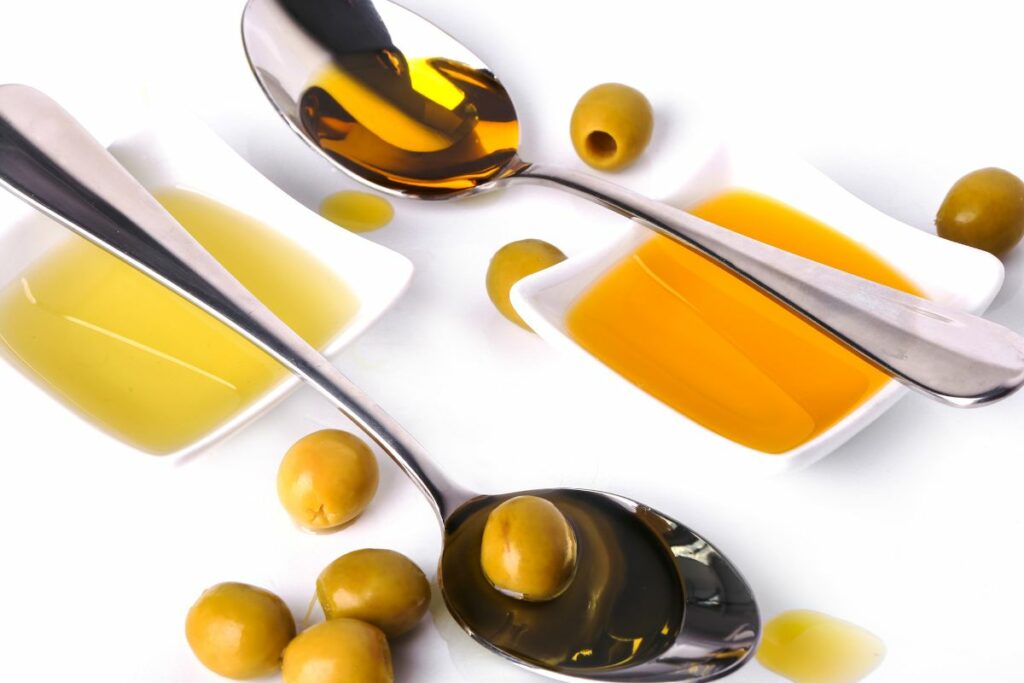
Other Unique Substitutes
While butter, shortening, and oils like coconut, vegetable, or olive are the most common substitutes for lard, there are other unique substitutes that can be used in specific situations.
One such substitute is mashed banana. Mashed banana can be a great substitute for lard in baking recipes like muffins, cakes, and bread. It adds moisture and a subtle sweetness to the recipe, making it a healthier alternative to lard. However, it is important to note that using mashed banana may alter the flavor and texture of the final product.
Another unique substitute for lard is beef tallow. Beef tallow has a similar texture and flavor to lard, making it a great substitute for frying and sautéing. It is important to note that beef tallow is high in saturated fat, so it should be used in moderation.
Bacon grease is another unique substitute for lard. It has a similar flavor profile and can be used in recipes that call for lard, such as biscuits and pie crusts. However, it is important to note that bacon grease is also high in saturated fat and should be used in moderation.
When substituting lard with any of these unique substitutes, it is important to adjust the recipe accordingly and experiment with the amount used to achieve the desired results.
Choosing the Right Substitute
When it comes to choosing the right substitute for lard, there are several factors to consider. The taste, flavor, texture, color, and consistency of the substitute are all important factors to keep in mind.
For those who are looking for a neutral taste, vegetable shortening is a good option. It has a mild flavor that won’t overpower the other ingredients in the recipe. On the other hand, butter has a rich flavor that can add a delicious touch to baked goods.
Texture is another important factor to consider. If the recipe calls for a specific texture, such as flakiness or crispiness, it’s important to choose a substitute that will achieve that texture. For example, coconut oil is a good substitute for lard when it comes to achieving a crispy texture.
Color is also something to consider, especially if the appearance of the final product is important. If the recipe calls for a light color, such as in pie crusts or biscuits, butter or vegetable shortening may be a better option than coconut oil, which can give a slightly yellow tint.

For those who are looking for a substitute that can be used in a 1:1 ratio, vegetable shortening is a great option. It has a similar consistency to lard and can be used interchangeably in most recipes.
Finally, versatility is an important factor to consider. Some substitutes, such as coconut oil, may not be suitable for all recipes. It’s important to choose a substitute that can be used in a variety of recipes, from baked goods to savory dishes.
Overall, choosing the right substitute for lard depends on the specific recipe and personal preferences. By keeping these factors in mind, it’s possible to find a substitute that will work well in any recipe.
Substitutes for Specific Recipes
When it comes to specific recipes, finding the right substitute for lard can be a challenge. However, with a little experimentation and knowledge of the recipe, it is possible to find a suitable replacement that will yield delicious results.
Pie Crusts
Pie crusts are a classic recipe that often calls for lard. However, there are several substitutes that can work just as well. Butter, vegetable shortening, and coconut oil are all great options that will yield a flaky and delicious crust. For a vegan option, try using vegetable shortening or coconut oil.
Tortillas
Tortillas are a staple in many households, but they often call for lard. For a healthier option, try using olive oil or vegetable oil instead of lard. Both oils are great substitutes that will yield a soft and pliable tortilla.
Tamale Dough
Tamale dough is a traditional recipe that often calls for lard. However, there are several substitutes that can work just as well. Vegetable shortening, coconut oil, and olive oil are all great options that will yield a delicious and authentic tamale dough.
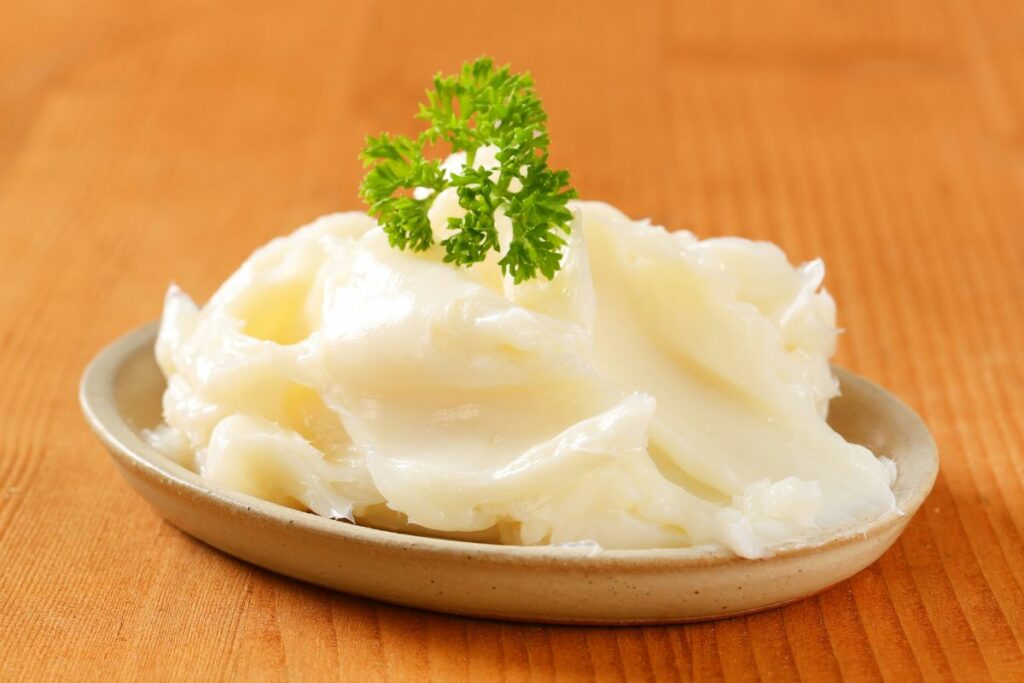
Baked Goods
Baked goods such as cakes and cookies often call for lard. For a healthier option, try using coconut oil or vegetable oil instead of lard. Both oils are great substitutes that will yield a moist and delicious baked good.
Savory Dishes
Savory dishes such as fried chicken often call for lard. For a healthier option, try using vegetable oil or olive oil instead of lard. Both oils are great substitutes that will yield a crispy and delicious dish.
Overall, there are several substitutes for lard that can work just as well in specific recipes. It is important to experiment and find the right substitute that will yield delicious results.
Health Considerations
When it comes to cooking and baking, lard is a popular ingredient that adds flavor and texture to dishes. However, it is also high in saturated fat, which can have negative effects on heart health. Therefore, it is important to consider healthier substitutes for lard.
Fat Content
Lard is made from pig fat and is high in saturated fat, which can increase cholesterol levels and contribute to heart disease. One tablespoon of lard contains around 12 grams of fat, including 5 grams of saturated fat. In comparison, one tablespoon of butter contains around 11 grams of fat, including 7 grams of saturated fat.
Saturated Fat
Saturated fat is known to increase LDL (bad) cholesterol levels, which can lead to a buildup of plaque in the arteries and increase the risk of heart disease. Therefore, it is recommended to limit intake of saturated fat to less than 10% of daily calories.
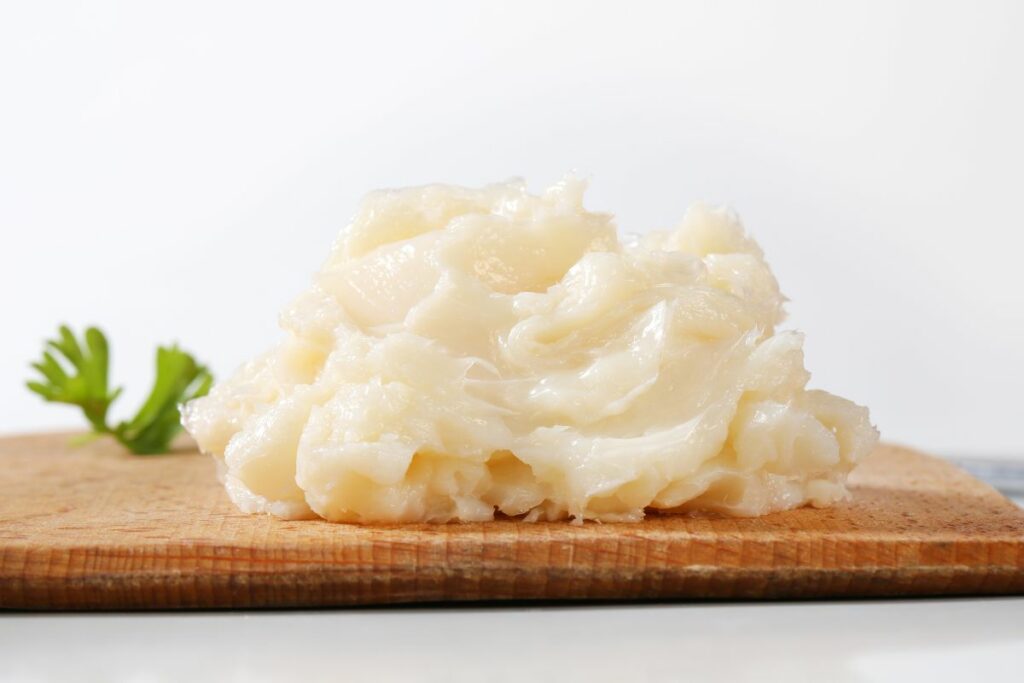
Unsaturated Fat and Fatty Acids
Healthier substitutes for lard include oils that are high in unsaturated fats, such as olive oil and canola oil. These oils contain monounsaturated and polyunsaturated fatty acids, which have been shown to have health benefits, including reducing the risk of heart disease.
Trans Fat
Trans fat is a type of fat that is often found in processed foods and can increase LDL cholesterol levels and decrease HDL (good) cholesterol levels. It is recommended to avoid trans fat as much as possible.
Health Benefits
Using healthier substitutes for lard can have health benefits, including reducing the risk of heart disease and improving overall health. For example, olive oil has been shown to have anti-inflammatory properties and can help lower blood pressure. Canola oil is also a good source of omega-3 fatty acids, which can help reduce inflammation and improve heart health.
In summary, while lard can add flavor and texture to dishes, it is important to consider healthier substitutes that are lower in saturated fat and higher in unsaturated fats. Using healthier oils can have health benefits and reduce the risk of heart disease.
Considerations for Dietary Restrictions
When looking for a lard substitute, it’s important to consider dietary restrictions. There are various reasons why someone may avoid lard, including religious beliefs, ethical concerns, or health issues. Here are some considerations for those with dietary restrictions:
Vegan and Vegetarian Options
For those following a vegan or vegetarian diet, animal-based lard is not an option. Fortunately, there are many plant-based alternatives that can be used instead. Some options include coconut oil, vegetable shortening, and vegan butter. These substitutes can be used in a 1:1 ratio with lard in most recipes.
Halal Diet
In the Islamic faith, certain foods are considered halal, or permissible to eat. Pork and its by-products, including lard, are not halal. For those following a halal diet, vegetable shortening or coconut oil can be used as a substitute for lard. It’s important to check the ingredients list to ensure that the substitute is halal-certified.
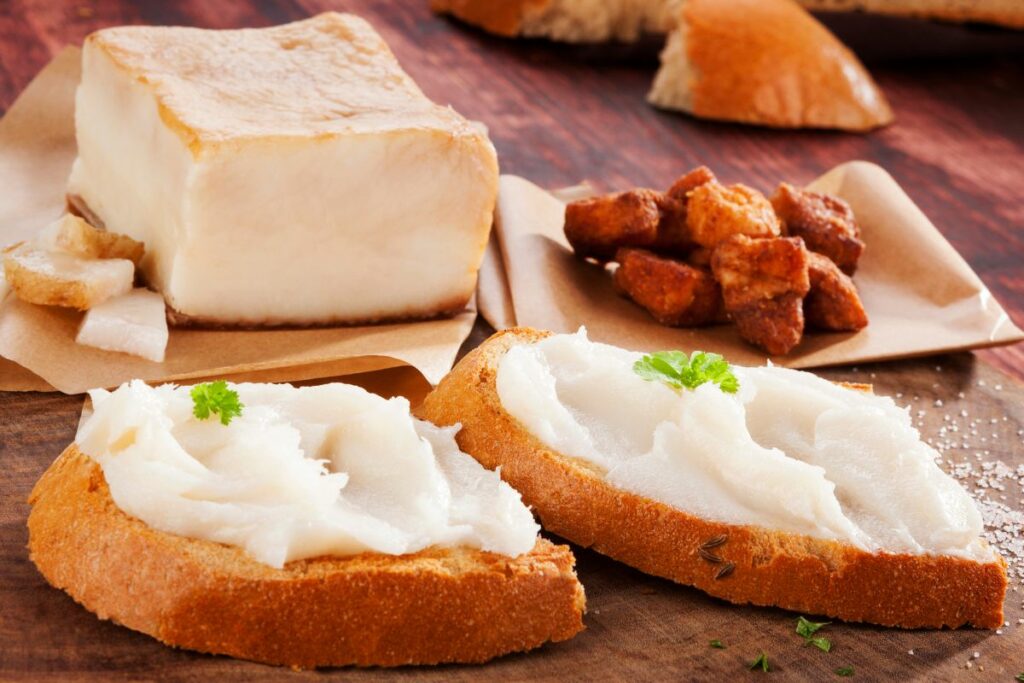
Health Concerns
Lard is high in saturated fat and cholesterol, which can increase the risk of heart disease and other health issues. For those with health concerns, it’s important to choose a substitute that is lower in saturated fat and cholesterol. Some options include vegetable oil, olive oil, and avocado oil. These substitutes are also lower in calories than lard.
When choosing a lard substitute, it’s important to consider individual dietary needs and preferences. By choosing a suitable substitute, one can still enjoy the same taste and texture in their favorite recipes while adhering to their dietary restrictions.
Lard and Its Substitutes in Grocery Stores
When it comes to cooking and baking, lard is a popular ingredient, especially in traditional recipes. However, not everyone wants to use lard due to health concerns or dietary restrictions. Fortunately, there are several lard substitutes available in grocery stores that can be used in place of lard.
One popular substitute for lard is Crisco, a vegetable shortening that has been around for over a century. It is made from vegetable oil and has a neutral flavor, making it a versatile ingredient in a variety of recipes. Crisco has a long shelf life, so it can be stored in the pantry for extended periods of time.
Other substitutes for lard that can be found in grocery stores include butter, coconut oil, and olive oil. Butter is a common substitute for lard in baking recipes and can add a rich flavor to dishes. Coconut oil is a popular substitute for those following a vegan or plant-based diet and can be used in both sweet and savory recipes. Olive oil is another healthy substitute for lard and can add a fruity flavor to dishes.
When shopping for lard substitutes in grocery stores, it is important to read the labels carefully. Some vegetable shortening products may contain trans fats, which can be harmful to health. It is best to choose substitutes that are made from natural ingredients and have a low amount of saturated fat.
In conclusion, there are several lard substitutes available in grocery stores that can be used in place of lard. Crisco, butter, coconut oil, and olive oil are all popular substitutes that can be found in most grocery stores. When choosing a substitute, it is important to read the labels carefully and choose products that are made from natural ingredients and have a low amount of saturated fat.
